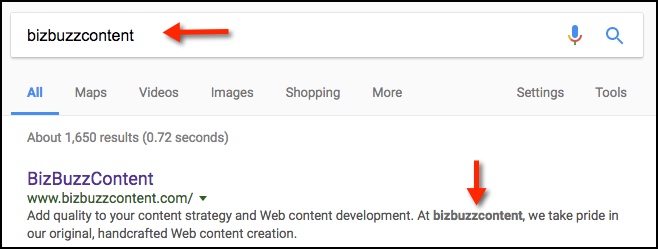If you’re in the business of content creation for the web, you may have heard of Meta data, also called Meta information or Meta tags. In a nutshell, Meta data is a concise explanation of the content on a web page (or in an image, video or spreadsheet). It appears on search engine results pages (SERPs) as your web page’s title and snippet, like so:
Search engines use Meta data to “understand” what web pages are about, and then display that information for users in the search results. Content creators should view Meta data as a marketing opportunity, using it to grab readers’ attention and encourage them to click through to the site. Think of it as an advertisement that gives a clear and compelling picture of what’s on a web page.
Sure, it’s not the most glamorous part of writing, but it’s a key point in your online marketing strategy. If you haven’t encountered it yet, you will.
The Basics
If writing Meta data is new to you, here are the basics for doing so effectively:
- Meta data for a web page has two major components: The Title tag and the Description tag. Every web page should have unique information for each.
- Meta data lives in the source code in the Head section of a webpage. You want it at the top of the page as it’s among the first pieces of code search engine spiders encounter (many platforms do that automatically).
Title and Description tags get compressed on SERPs. At the time of writing, Google limits Titles to 70 characters and Descriptions to 100 characters per line (though the actual measurements are in pixels, not characters). However, Moz currently recommends keeping Titles between 50 and 60 characters and Descriptions to 300 characters or less. Keep in mind that these limits may change – we’ll get to that later in the post.
Some additional tips:
- Incorporate important keywords naturally, closer to the beginning of the tags. Use keywords only once in Titles and no more than twice in Descriptions.
- There is a third component, the Keyword tag, though it has little use these days and can generally be omitted.
- Brand names do not have to be included in the Title tag. Of course, if the recognized brand name will entice a user to click through and maybe convert, it’s well worth including. Decide whether or not to do so on a case-by-case basis, ensuring you always use natural-sounding language.
Title Tags
Title tags should give search engines and users the main theme of a page and prominently feature the most relevant keywords, which are naturally related to the topic on the page.
Some tips and guidelines:
- The Title is the link users click on to go to a page from the SERP, and sits right above the URL and Description.
- Search engines limit the character count they will display on the SERPs, so keep your Title within that number (about 60), or it will be compressed.
- Create natural-sounding and appealing Titles within the character count, never repeating a keyword more than once.
- When user searches match the keywords in your Title tag, those keywords will be bold so the users see what they’re looking for.
Description Tags
Description tags should be like an answer to a user query. They appear under the Title tag on SERPs and give a glimpse into what’s on the page. If the brand name doesn’t fit easily into the Title, this can be a good place for it.
Meta Descriptions won’t necessarily help your ranking within Google, but a good one can catch the eye of users when their search terms are bolded (as in the image above).
Be aware that, even if you carefully craft a Description, Google might not use it. The snippets shown on SERPs are generated through a fully automated process, and Google displays what it thinks best represents the content and relates it to the user’s query.
Some tips and guidelines:
- Descriptions should be complete sentences with the most important information and keywords at the beginning.
- You can reuse Title tag keywords in the Description, as it will show the reader you truly focus on what they’ve searched.
- Limit the character count of your description to about 300 (including spaces) so that the search engine doesn’t cut it off.
- Don’t use a keyword more than twice in a Description. If important keyword phrases use some of the same words, combine them to keep things succinct. For example, if you want to use “preschool songs” and “preschool lessons,” put them together for “preschool lessons and songs.”
Quality Meta Data That Stands Out
To make yourself a little more competitive, do a quick search of your keywords to see what your competitors’ Meta data looks like. Think of ways to make yours stand out, like including your phone number in the Description of your contact page.
Use natural language throughout and “stemming” when it comes to keywords. Stemming is including different forms (plurals, changed tense) of keywords because search engines understands that they’re related.
Be wary of creating duplicate content. Every single web page should have unique Meta data (especially Titles) to reflect its unique focus. If some of your pages contain very similar Meta data, you risk search engines filtering some pages out as “duplicate content,” even if the pages are quite different.
Let’s bring it all together for an example of how your Meta data might look. We’ll use the keyword phrase “kitten sweaters:”
Meta Title: Kitten Sweaters for All Ages!
Meta Description: Show your love for crazy kitties with kitten sweaters in a range of styles and colors. Find gift ideas for friends of all ages!
Possible Changes to Meta Data Character Limits
We’ve stressed a few times that keeping your Title and Description under a certain length means the search engines won’t cut them off, altering how users first encounter your page.
Early in 2016, people started noticing longer Meta titles on Google SERPs, some with as many as 70 characters (78 on mobile!). Some expansion to Descriptions was also noticed, with a few showing three lines instead of two and 100 characters per line. By the end of 2017, Moz is regularly seeing descriptions as long as 300 characters, though video content seems to have its descriptions snipped by 200 characters (see “Descriptions” link in “The Basics” section).
It’s important to understand that Google measures Title length and other search results factors by pixels, not number of characters, as we mentioned earlier. Characters are a more practical measurement for marketers, though an approximation. Not displaying right-hand-side ads—a change also made in 2016—may have been one reason for that change.
We bring this up because guidelines, just like search engines, will update at the drop of a hat, and you want to ensure you’re always up to date.
Understanding Meta data, what it does and how to create it are vital for a content marketer. Hopefully, the basics and tips we’ve shared here will help you make the most of this tool.
Have comments? Share them with me below!
This post was updated in December of 2017 to reflect new Moz recommendations.




Thanks for the share Katie, great article.
I want to ask you.
How much time does it take for you to write the perfect compelling seo friendly meta info?
Kind regards,
Filip
Thanks, Filip! For once piece, writing the meta info might take just a few minutes. However, if I’m creating meta info for several pieces and managing multiple keywords etc. it can take longer, as there’s more to keep track of (such as not being repetitive).